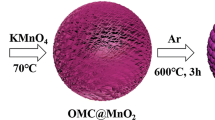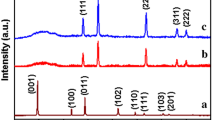Abstract
Mesocrystals are macroscopic structures formed by the assembly of nanoparticles that possess distinct surface structures and collective properties when compared to traditional crystalline materials. Various growth mechanisms and their unique features have promise as material design tools for diverse potential applications. This paper presents a straightforward method for metal–organic coordination-based mesocrystals using nickel ions and terephthalic acid. The coordinative compound between Ni2+ and terephthalic acid drives the particle-mediated growth mechanism, resulting in the mesocrystal formation through a mesoscale assembly. Subsequent carbonization converts mesocrystals to multidirectional interconnected graphite nanospheres along the macroscopic framework while preserving the original structure of the Ni-terephthalic acid mesocrystal. Comprehensive investigations demonstrate that multi-oriented edge sites and high crystallinity with larger interlayer spacing facilitate lithium ion transport and continuous intercalation. The resulting graphitic superparticle electrodes show superior rate capability (128.6 mAh g−1 at 5 A g−1) and stable cycle stability (0.052% of capacity decay per cycle), certifying it as an advanced anode material for lithium-ion batteries.





Similar content being viewed by others
Data availability
Data will be made available on request.
References
Kim Y-Y, Schenk AS, Ihli J, Kulak AN, Hetherington NB, Tang CC, Schmahl WW, Griesshaber E, Hyett G, Meldrum FC (2014) A critical analysis of calcium carbonate mesocrystals. Nat Commun 5(1):4341. https://doi.org/10.1038/ncomms5341
Cölfen H, Antonietti M (2005) Mesocrystals: inorganic superstructures made by highly parallel crystallization and controlled alignment. Angew Chem Int Ed 44(35):5576–5591. https://doi.org/10.1002/anie.200500496
Sturm EV, Cölfen H (2016) Mesocrystals: structural and morphogenetic aspects. Chem Soc Rev 45:5821–5833. https://doi.org/10.1039/C6CS00208K
Yuwono VM, Burrows ND, Soltis JA, Penn RL (2010) Oriented aggregation: formation and transformation of mesocrystal intermediates revealed. J Am Chem Soc 132(7):2163–2165. https://doi.org/10.1021/ja909769a
Wi S, Park J, Lee S, Kim J, Gil B, Yun AJ, Sung Y-E, Park B, Kim C (2017) Insights on the delithiation/lithiation reactions of LixMn0.8Fe0.2PO4 mesocrystals in Li+ batteries by in situ techniques. Nano Energy 39:371–379. https://doi.org/10.1016/j.nanoen.2017.07.016
Song RQ, Cölfen H (2010) Mesocrystals-ordered nanoparticle superstructures. Adv Mater 22(12):1301–1330. https://doi.org/10.1002/adma.200901365
Zhu G, Sushko ML, Loring JS, Legg BA, Song M, Soltis JA, Huang X, Rosso KM, De Yoreo JJ (2021) Self-similar mesocrystals form via interface-driven nucleation and assembly. Nature 590(7846):416–422. https://doi.org/10.1038/s41586-021-03300-0
Schlotheuber né Brunner J, Maier B, Thomä SLJ, Kirner F, Baburin IA, Lapkin D, Rosenberg R, Sturm S, Assalauova D, Carnis J, Kim YY, Ren Z, Westermeier F, Theiss S, Borrmann H, Polarz S, Eychmüller A, Lubk A, Vartanyants IA, Cölfen H, Zobel M, Sturm EV (2021) Morphogenesis of magnetite mesocrystals: interplay between nanoparticle morphology and solvation shell. Chem Mater 33(23):9119–9130. https://doi.org/10.1021/acs.chemmater.1c01941
Park JS, Kim JH, Yang SJ (2021) Rational design of metal–organic framework-based materials for advanced Li–S Batteries. Bull Korean Chem Soc 42(2):148–158. https://doi.org/10.1002/bkcs.12184
Ni B, Gonzalez-Rubio G, Colfen H (2022) Self-assembly of colloidal nanocrystals into 3D binary mesocrystals. Acc Chem Res 55(12):1599–1608. https://doi.org/10.1021/acs.accounts.2c00074
Dong L, Gao ZA, Lin N (2016) Self-assembly of metal–organic coordination structures on surfaces. Prog Surf Sci 91(3):101–135. https://doi.org/10.1016/j.progsurf.2016.08.001
Shu JC, Huang XY, Cao MS (2021) Assembling 3D flower-like Co3O4-MWCNT architecture for optimizing low-frequency microwave absorption. Carbon 174:638–646. https://doi.org/10.1016/j.carbon.2020.11.087
Ahmadijokani F, Molavi H, Tajahmadi S, Rezakazemi M, Amini M, Kamkar M, Rojas OJ, Arjmand M (2022) Coordination chemistry of metal–organic frameworks: detection, adsorption, and photodegradation of tetracycline antibiotics and beyond. Coord Chem Rev 464:214562. https://doi.org/10.1016/j.ccr.2022.214562
Pardo E, Train C, Gontard G, Boubekeur K, Fabelo O, Liu H, Dkhil B, Lloret F, Nakagawa K, Tokoro H, Ohkoshi S, Verdaguer M (2011) High proton conduction in a chiral ferromagnetic metal–organic quartz-like framework. J Am Chem Soc 133(39):15328–15331. https://doi.org/10.1021/ja206917z
Xia W, Mahmood A, Zou R, Xu Q (2015) Metal–organic frameworks and their derived nanostructures for electrochemical energy storage and conversion. Energy Environ Sci 8:1837–1866. https://doi.org/10.1039/c5ee00762c
Hwang J, Heil T, Antonietti M, Schmidt B (2018) Morphogenesis of metal–organic mesocrystals mediated by double hydrophilic block copolymers. J Am Chem Soc 140(8):2947–2956. https://doi.org/10.1021/jacs.7b12633
Zou RQ, Sakurai H, Xu Q (2006) Preparation, adsorption properties, and catalytic activity of 3D porous metal–organic frameworks composed of cubic building blocks and alkali-metal ions. Angew Chem Int Ed 45(16):2542–2546. https://doi.org/10.1002/anie.200503923
Park JS, Han YB, So SH, Kim J, Ryu JH, Choi J, Park DH, Park CR, Kim JH, Yang SJ (2022) Concentration-driven polymorphic mesocrystal and morphosynthetic transformation toward omni-adsorbent with the widest range of pores. Chem Eng J 433:133871. https://doi.org/10.1016/j.cej.2021.133871
Cao S, Lu YB, Tang YJ, Sun YY, Zhou HJ, Zhang GX, Lin XY, Pang H (2024) Constructing ion-transport blockchain by polypyrrole to link CoTi–ZIF-9 derived carbon materials for high-performance seawater desalination. J Colloid Interface Sci 654:466–475. https://doi.org/10.1016/j.jcis.2023.10.065
Ahn WJ, Park BH, Seo SW, Kim S, Im JS (2023) Designing of 3D porous silicon/carbon complex anode based on metal–organic frameworks for lithium-ion battery. Carbon Lett 33(7):2349–2361. https://doi.org/10.1007/s42823-023-00572-6
Shu JC, Cao WQ, Cao MS (2021) Diverse metal–organic framework architectures for electromagnetic absorbers and shielding. Adv Funct Mater 31(23):2100470. https://doi.org/10.1002/adfm.202100470
Zhu JX, Sakaushi K, Clavel G, Shalom M, Antonietti M, Fellinger TP (2015) A general salt-templating method to fabricate vertically aligned graphitic carbon nanosheets and their metal carbide hybrids for superior lithium ion batteries and water splitting. J Am Chem Soc 137(16):5480–5485. https://doi.org/10.1021/jacs.5b01072
Eckardt M, Sakaushi K, Lyalin A, Wassner M, Hüsing N, Taketsugu T, Behm RJ (2019) The role of nitrogen-doping and the effect of the pH on the oxygen reduction reaction on highly active nitrided carbon sphere catalysts. Electrochim Acta 299:736–748. https://doi.org/10.1016/j.electacta.2019.01.046
Qiu X, Wang X, He Y, Liang J, Liang K, Tardy BL, Richardson JJ, Hu M, Wu H, Zhang Y (2021) Superstructured mesocrystals through multiple inherent molecular interactions for highly reversible sodium ion batteries. Sci Adv 7(37):eabh3482. https://doi.org/10.1126/sciadv.abh3482
Hu WH, Zheng MB, Xu BY, Wei Y, Zhu W, Li Q, Pang H (2021) Design of hollow carbon-based materials derived from metal–organic frameworks for electrocatalysis and electrochemical energy storage. J Mater Chem A 9(7):3880–3917. https://doi.org/10.1039/d0ta10666f
Pachfule P, Shinde D, Majumder M, Xu Q (2016) Fabrication of carbon nanorods and graphene nanoribbons from a metal–organic framework. Nat Chem 8(7):718–724. https://doi.org/10.1038/nchem.2515
Cai ZX, Wang ZL, Kim J, Yamauchi Y (2019) Hollow functional materials derived from metal–organic frameworks: synthetic strategies, conversion mechanisms, and electrochemical applications. Adv Mater 31(11):1804903. https://doi.org/10.1002/adma.201804903
Yang SJ, Antonietti M, Fechler N (2015) Self-assembly of metal phenolic mesocrystals and morphosynthetic transformation toward hierarchically porous carbons. J Am Chem Soc 137(25):8269–8273. https://doi.org/10.1021/jacs.5b04500
Hwang J, Walczak R, Oschatz M, Tarakina NV, Schmidt B (2019) Micro-blooming: hierarchically porous nitrogen-doped carbon flowers derived from metal–organic mesocrystals. Small 15(37):1901986. https://doi.org/10.1002/smll.201901986
Xu Z, Zhuang X, Yang C, Cao J, Yao Z, Tang Y, Jiang J, Wu D, Feng X (2016) Nitrogen-doped porous carbon superstructures derived from hierarchical assembly of polyimide nanosheets. Adv Mater 28(10):1981–1987. https://doi.org/10.1002/adma.201505131
Ganesan V, Lee YH, Jung H, Park CM (2023) Porous polyhedral carbon matrix for high-performance Li/Na/K-ion battery anodes. Carbon Lett 33(7):2189–2198. https://doi.org/10.1007/s42823-023-00559-3
Hadjiivanov KI, Panayotov DA, Mihaylov MY, Ivanova EZ, Chakarova KK, Andonova SM, Drenchev NL (2021) Power of infrared and raman spectroscopies to characterize metal–organic frameworks and investigate their interaction with guest molecules. Chem Rev 121(3):1286–1424. https://doi.org/10.1021/acs.chemrev.0c00487
Martín-Jimeno FJ, Suárez-García F, Paredes JI, Martínez-Alonso A, Tascón JMD (2021) Nickel nanoparticle/carbon catalysts derived from a novel aqueous-synthesized metal–organic framework for nitroarene reduction. J Alloys Compd 853:157348. https://doi.org/10.1016/j.jallcom.2020.157348
Yu B, Zhang Q, Hou L, Wang S, Song M, He Y, Huang H, Zou J (2016) Temperature-dependent chemical state of the nickel catalyst for the growth of carbon nanofibers. Carbon 96:904–910. https://doi.org/10.1016/j.carbon.2015.10.048
Wang LP, Yao ZX, Guo ZM, Shen XF, Li ZA, Zhou ZQ, Wang YL, Yang JG (2022) Effects of solvent extraction on the microstructure of bituminous coal-based graphite. Carbon Lett 32(3):741–749. https://doi.org/10.1007/s42823-021-00290-x
Li ZQ, Lu CJ, Xia ZP, Zhou Y, Luo Z (2007) X-ray diffraction patterns of graphite and turbostratic carbon. Carbon 45(8):1686–1695. https://doi.org/10.1016/j.carbon.2007.03.038
Li T, Tao L, Xu L, Meng T, Clifford BC, Li S, Zhao X, Rao J, Lin F, Hu L (2023) Direct and rapid high-temperature upcycling of degraded graphite. Adv Funct Mater 33(43):2302951. https://doi.org/10.1002/adfm.202302951
Yang D-S, Bhattacharjya D, Song MY, Yu J-S (2014) Highly efficient metal-free phosphorus-doped platelet ordered mesoporous carbon for electrocatalytic oxygen reduction. Carbon 67:736–743. https://doi.org/10.1016/j.carbon.2013.10.065
Sheng Y, Peng J, Ma L, Zhang Y, Jiang T, Li X (2022) Nickel nanoparticles embedded in porous carbon-coated honeycomb ceramics: a potential monolithic catalyst for continuous hydrogenation reaction. Carbon 197:171–182. https://doi.org/10.1016/j.carbon.2022.06.017
Hoekstra J, Beale AM, Soulimani F, Versluijs-Helder M, Geus JW, Jenneskens LW (2015) Base metal catalyzed graphitization of cellulose: a combined Raman spectroscopy, temperature-dependent X-ray diffraction and high-resolution transmission electron microscopy study. J Phys Chem C 119(19):10653–10661. https://doi.org/10.1021/acs.jpcc.5b00477
Hunter R, Ramírez-Rico J, Schnepp Z (2022) Iron-catalyzed graphitization for the synthesis of nanostructured graphitic carbons. J Mater Chem A 10(9):4489–4516. https://doi.org/10.1039/D1TA09654K
Park J-S, Lee M-H, Jeon I-Y, Park H-S, Baek J-B, Song H-K (2012) Edge-exfoliated graphites for facile kinetics of delithiation. ACS Nano 6(12):10770–10775. https://doi.org/10.1021/nn3050227
Liu Q, Ji Y, Yin X, Li J, Liu Y, Hu X, Wen Z (2022) Magnesiothermic reduction improved route to high-yield synthesis of interconnected porous Si@C networks anode of lithium ions batteries. Energy Storage Mater 46:384–393. https://doi.org/10.1016/j.ensm.2021.12.017
Shin MC, Kim JH, Nam S, Oh YJ, Jin HJ, Park CR, Zhang Q, Yang SJ (2020) Atomic-distributed coordination state of metal-phenolic compounds enabled low temperature graphitization for high-performance multioriented graphite anode. Small 16(33):2003104. https://doi.org/10.1002/smll.202003104
Oh YJ, Park JH, Park JS, Kim SS, Hong SJ, Na YW, Kim JH, Nam S, Yang SJ (2022) Fast-chargeable N-doped multi-oriented graphitic carbon as a Li-intercalation compound. Energy Storage Mater 44:416–424. https://doi.org/10.1016/j.ensm.2021.10.036
Ng S, Vix-Guterl C, Bernardo P, Tran N, Ufheil J, Buqa H, Dentzer J, Gadiou R, Spahr M, Goers D (2009) Correlations between surface properties of graphite and the first cycle specific charge loss in lithium-ion batteries. Carbon 47(3):705–712. https://doi.org/10.1016/j.carbon.2008.11.008
Liu D, Cao G (2010) Engineering nanostructured electrodes and fabrication of film electrodes for efficient lithium ion intercalation. Energy Environ Sci 3(9):1218–1237. https://doi.org/10.1039/B922656G
Xiang W, Chen M, Zhou X, Chen J, Huang H, Sun Z, Lu Y, Zhang G, Wen X, Li W (2022) Highly enforced rate capability of a graphite anode via interphase chemistry tailoring based on an electrolyte additive. J Phys Chem Lett 13(23):5151–5159. https://doi.org/10.1021/acs.jpclett.2c01183
Baek M, Kim J, Jin J, Choi JW (2021) Photochemically driven solid electrolyte interphase for extremely fast-charging lithium-ion batteries. Nat Commun 12(1):6807. https://doi.org/10.1038/s41467-021-27095-w
Zhao L, Jing D, Shi Y, Zhuang Q, Cui Y, Ju Z, Cui Y (2020) TriMethylene sulfite as a novel additive for SEI film formation in lithium-ion batteries. Ionics 26:4813–4824. https://doi.org/10.1007/s11581-020-03650-1
Seo J-U, Park C-M (2014) ZnTe and ZnTe/C nanocomposite: a new electrode material for high-performance rechargeable Li-ion batteries. J Mater Chem A 2(47):20075–20082. https://doi.org/10.1039/C4TA04854G
Kim J, Lee S, Song WJ, Lee KJ (2023) Syringeless electrospun non-woven separator membrane for high-energy and high-power Li-ion battery application. J Alloys Compd 968:171882. https://doi.org/10.1016/j.jallcom.2023.171882
Acknowledgements
This research was supported by the Technology Innovation Program (20017548 and 20010853) funded by the Ministry of Trade, Industry & Energy (MOTIE, Korea). This work was supported by RIST.
Author information
Authors and Affiliations
Corresponding authors
Ethics declarations
Conflict of interest
The authors declare that there is no conflict of interest.
Additional information
Publisher's Note
Springer Nature remains neutral with regard to jurisdictional claims in published maps and institutional affiliations.
Supplementary Information
Below is the link to the electronic supplementary material.
Rights and permissions
Springer Nature or its licensor (e.g. a society or other partner) holds exclusive rights to this article under a publishing agreement with the author(s) or other rightsholder(s); author self-archiving of the accepted manuscript version of this article is solely governed by the terms of such publishing agreement and applicable law.
About this article
Cite this article
Park, J.S., Jeong, Y.J., Park, D.Y. et al. Superparticle of multidirectional graphitic nanospheres derived from metal–organic mesocrystal for fast-chargeable lithium-ion battery anode. Carbon Lett. (2024). https://doi.org/10.1007/s42823-024-00740-2
Received:
Revised:
Accepted:
Published:
DOI: https://doi.org/10.1007/s42823-024-00740-2




